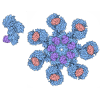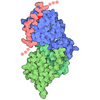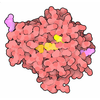+ Open data
Open data
- Basic information
Basic information
| Entry |  | |||||||||
|---|---|---|---|---|---|---|---|---|---|---|
| Title | Cryo-EM structure of mouse RIPK1-DD filament | |||||||||
 Map data Map data | ||||||||||
 Sample Sample |
| |||||||||
 Keywords Keywords | RIPK1 / death domain / 568-656 / dimerization / IMMUNE SYSTEM | |||||||||
| Function / homology |  Function and homology information Function and homology informationTNF signaling / Regulation by c-FLIP / CASP8 activity is inhibited / Dimerization of procaspase-8 / TNFR1-induced proapoptotic signaling / Caspase activation via Death Receptors in the presence of ligand / RIPK1-mediated regulated necrosis / TRIF-mediated programmed cell death / ripoptosome assembly / positive regulation of miRNA processing ...TNF signaling / Regulation by c-FLIP / CASP8 activity is inhibited / Dimerization of procaspase-8 / TNFR1-induced proapoptotic signaling / Caspase activation via Death Receptors in the presence of ligand / RIPK1-mediated regulated necrosis / TRIF-mediated programmed cell death / ripoptosome assembly / positive regulation of miRNA processing / positive regulation of interleukin-6-mediated signaling pathway / ripoptosome assembly involved in necroptotic process / TNFR1-induced NF-kappa-B signaling pathway / death domain binding / Regulation of TNFR1 signaling / Regulation of necroptotic cell death / Ovarian tumor domain proteases / IKK complex recruitment mediated by RIP1 / peptidyl-serine autophosphorylation / ripoptosome / programmed necrotic cell death / positive regulation of macrophage differentiation / T cell apoptotic process / TRP channels / necroptotic signaling pathway / Ub-specific processing proteases / death-inducing signaling complex / positive regulation of necroptotic process / negative regulation of necroptotic process / positive regulation of tumor necrosis factor-mediated signaling pathway / death receptor binding / positive regulation of extrinsic apoptotic signaling pathway / regulation of reactive oxygen species metabolic process / necroptotic process / positive regulation of phosphorylation / extrinsic apoptotic signaling pathway via death domain receptors / positive regulation of execution phase of apoptosis / negative regulation of extrinsic apoptotic signaling pathway in absence of ligand / signaling adaptor activity / negative regulation of canonical NF-kappaB signal transduction / tumor necrosis factor-mediated signaling pathway / positive regulation of interleukin-8 production / negative regulation of extrinsic apoptotic signaling pathway / positive regulation of JNK cascade / protein catabolic process / positive regulation of non-canonical NF-kappaB signal transduction / : / cellular response to growth factor stimulus / cellular response to hydrogen peroxide / positive regulation of protein phosphorylation / positive regulation of inflammatory response / positive regulation of tumor necrosis factor production / cellular response to tumor necrosis factor / positive regulation of neuron apoptotic process / protein autophosphorylation / amyloid fibril formation / non-specific serine/threonine protein kinase / positive regulation of canonical NF-kappaB signal transduction / protein kinase activity / receptor complex / positive regulation of MAPK cascade / intracellular signal transduction / positive regulation of apoptotic process / inflammatory response / protein serine kinase activity / protein serine/threonine kinase activity / apoptotic process / ubiquitin protein ligase binding / negative regulation of apoptotic process / protein-containing complex binding / protein homodimerization activity / positive regulation of transcription by RNA polymerase II / mitochondrion / ATP binding Similarity search - Function | |||||||||
| Biological species |  | |||||||||
| Method | helical reconstruction / cryo EM / Resolution: 3.02 Å | |||||||||
 Authors Authors | Zhang H | |||||||||
| Funding support |  China, 2 items China, 2 items
| |||||||||
 Citation Citation |  Journal: Cell Metab / Year: 2025 Journal: Cell Metab / Year: 2025Title: RIPK1 senses S-adenosylmethionine scarcity to drive cell death and inflammation. Authors: Zezhao Chen / Xiaosong Gu / Hongbo Chen / Huijing Zhang / Jianping Liu / Xiaohua Yang / Yuping Cai / Mengmeng Zhang / Lingjie Yan / Yuanxin Yang / Bing Shan / Zheng-Jiang Zhu / Yixiao Zhang ...Authors: Zezhao Chen / Xiaosong Gu / Hongbo Chen / Huijing Zhang / Jianping Liu / Xiaohua Yang / Yuping Cai / Mengmeng Zhang / Lingjie Yan / Yuanxin Yang / Bing Shan / Zheng-Jiang Zhu / Yixiao Zhang / Jinyang Gu / Daichao Xu /  Abstract: The capacity of cells to sense and respond to nutrient availability is essential for metabolic homeostasis. Failure in this process may cause cell death and associated diseases. While nutrient ...The capacity of cells to sense and respond to nutrient availability is essential for metabolic homeostasis. Failure in this process may cause cell death and associated diseases. While nutrient sensing in metabolic pathways is well understood, the mechanisms linking nutrient signals to cell death remain unclear. Here, we show that RIPK1, a key mediator of cell death and inflammation, senses methionine and its metabolite, S-adenosylmethionine (SAM), to dictate cell survival and death. SAM-mediated symmetrical dimethylation at RIPK1 Arg606 by PRMT5 functions as a physiological protective brake against RIPK1 activation. Metabolic perturbations, such as methionine restriction or disrupted one-carbon flux, reduce SAM levels and unmask Arg606, promoting RIPK1 self-association and trans-activation, thereby triggering apoptosis and inflammation. Thus, RIPK1 is a physiological SAM sensor linking methionine and one-carbon metabolism to the control of life-or-death decisions. Our findings suggest that RIPK1 could be a potential target for diseases associated with disrupted SAM availability. | |||||||||
| History |
|
- Structure visualization
Structure visualization
| Supplemental images |
|---|
- Downloads & links
Downloads & links
-EMDB archive
| Map data |  emd_62587.map.gz emd_62587.map.gz | 230 MB |  EMDB map data format EMDB map data format | |
|---|---|---|---|---|
| Header (meta data) |  emd-62587-v30.xml emd-62587-v30.xml emd-62587.xml emd-62587.xml | 14.6 KB 14.6 KB | Display Display |  EMDB header EMDB header |
| Images |  emd_62587.png emd_62587.png | 31.8 KB | ||
| Filedesc metadata |  emd-62587.cif.gz emd-62587.cif.gz | 5.4 KB | ||
| Others |  emd_62587_half_map_1.map.gz emd_62587_half_map_1.map.gz emd_62587_half_map_2.map.gz emd_62587_half_map_2.map.gz | 226.9 MB 226.9 MB | ||
| Archive directory |  http://ftp.pdbj.org/pub/emdb/structures/EMD-62587 http://ftp.pdbj.org/pub/emdb/structures/EMD-62587 ftp://ftp.pdbj.org/pub/emdb/structures/EMD-62587 ftp://ftp.pdbj.org/pub/emdb/structures/EMD-62587 | HTTPS FTP |
-Validation report
| Summary document |  emd_62587_validation.pdf.gz emd_62587_validation.pdf.gz | 950.6 KB | Display |  EMDB validaton report EMDB validaton report |
|---|---|---|---|---|
| Full document |  emd_62587_full_validation.pdf.gz emd_62587_full_validation.pdf.gz | 950.2 KB | Display | |
| Data in XML |  emd_62587_validation.xml.gz emd_62587_validation.xml.gz | 16.1 KB | Display | |
| Data in CIF |  emd_62587_validation.cif.gz emd_62587_validation.cif.gz | 19.2 KB | Display | |
| Arichive directory |  https://ftp.pdbj.org/pub/emdb/validation_reports/EMD-62587 https://ftp.pdbj.org/pub/emdb/validation_reports/EMD-62587 ftp://ftp.pdbj.org/pub/emdb/validation_reports/EMD-62587 ftp://ftp.pdbj.org/pub/emdb/validation_reports/EMD-62587 | HTTPS FTP |
-Related structure data
| Related structure data |  9kv7MC M: atomic model generated by this map C: citing same article ( |
|---|---|
| Similar structure data | Similarity search - Function & homology  F&H Search F&H Search |
- Links
Links
| EMDB pages |  EMDB (EBI/PDBe) / EMDB (EBI/PDBe) /  EMDataResource EMDataResource |
|---|---|
| Related items in Molecule of the Month |
- Map
Map
| File |  Download / File: emd_62587.map.gz / Format: CCP4 / Size: 244.1 MB / Type: IMAGE STORED AS FLOATING POINT NUMBER (4 BYTES) Download / File: emd_62587.map.gz / Format: CCP4 / Size: 244.1 MB / Type: IMAGE STORED AS FLOATING POINT NUMBER (4 BYTES) | ||||||||||||||||||||||||||||||||||||
|---|---|---|---|---|---|---|---|---|---|---|---|---|---|---|---|---|---|---|---|---|---|---|---|---|---|---|---|---|---|---|---|---|---|---|---|---|---|
| Projections & slices | Image control
Images are generated by Spider. | ||||||||||||||||||||||||||||||||||||
| Voxel size | X=Y=Z: 1.055 Å | ||||||||||||||||||||||||||||||||||||
| Density |
| ||||||||||||||||||||||||||||||||||||
| Symmetry | Space group: 1 | ||||||||||||||||||||||||||||||||||||
| Details | EMDB XML:
|
-Supplemental data
-Half map: #2
| File | emd_62587_half_map_1.map | ||||||||||||
|---|---|---|---|---|---|---|---|---|---|---|---|---|---|
| Projections & Slices |
| ||||||||||||
| Density Histograms |
-Half map: #1
| File | emd_62587_half_map_2.map | ||||||||||||
|---|---|---|---|---|---|---|---|---|---|---|---|---|---|
| Projections & Slices |
| ||||||||||||
| Density Histograms |
- Sample components
Sample components
-Entire : Receptor-interacting serine/threonine-protein kinase 1
| Entire | Name: Receptor-interacting serine/threonine-protein kinase 1 |
|---|---|
| Components |
|
-Supramolecule #1: Receptor-interacting serine/threonine-protein kinase 1
| Supramolecule | Name: Receptor-interacting serine/threonine-protein kinase 1 type: complex / ID: 1 / Parent: 0 / Macromolecule list: all |
|---|---|
| Source (natural) | Organism:  |
| Molecular weight | Theoretical: 1.017 KDa |
-Macromolecule #1: Receptor-interacting serine/threonine-protein kinase 1
| Macromolecule | Name: Receptor-interacting serine/threonine-protein kinase 1 type: protein_or_peptide / ID: 1 / Number of copies: 23 / Enantiomer: LEVO / EC number: non-specific serine/threonine protein kinase |
|---|---|
| Source (natural) | Organism:  |
| Molecular weight | Theoretical: 13.81067 KDa |
| Recombinant expression | Organism:  |
| Sequence | String: MGSSHHHHHH SSGLVPRGSH MLEVLFQGPV DTDEHLNPIR ENLGRQWKNC ARKLGFTESQ IDEIDHDYER DGLKEKVYQM LQKWLMREG TKGATVGKLA QALHQCCRID LLNHLIRASQ S UniProtKB: Receptor-interacting serine/threonine-protein kinase 1 |
-Experimental details
-Structure determination
| Method | cryo EM |
|---|---|
 Processing Processing | helical reconstruction |
| Aggregation state | filament |
- Sample preparation
Sample preparation
| Buffer | pH: 7.5 |
|---|---|
| Vitrification | Cryogen name: ETHANE-PROPANE |
- Electron microscopy
Electron microscopy
| Microscope | TFS KRIOS |
|---|---|
| Image recording | Film or detector model: GATAN K3 (6k x 4k) / Average electron dose: 49.41 e/Å2 |
| Electron beam | Acceleration voltage: 300 kV / Electron source:  FIELD EMISSION GUN FIELD EMISSION GUN |
| Electron optics | Illumination mode: FLOOD BEAM / Imaging mode: BRIGHT FIELD / Nominal defocus max: 2.4 µm / Nominal defocus min: 1.4000000000000001 µm |
| Experimental equipment |  Model: Titan Krios / Image courtesy: FEI Company |
- Image processing
Image processing
| Final reconstruction | Applied symmetry - Helical parameters - Δz: 4.96 Å Applied symmetry - Helical parameters - Δ&Phi: 139.82 ° Applied symmetry - Helical parameters - Axial symmetry: C1 (asymmetric) Resolution.type: BY AUTHOR / Resolution: 3.02 Å / Resolution method: FSC 0.143 CUT-OFF / Number images used: 988646 |
|---|---|
| CTF correction | Type: PHASE FLIPPING AND AMPLITUDE CORRECTION |
| Startup model | Type of model: OTHER |
| Final angle assignment | Type: NOT APPLICABLE |
 Movie
Movie Controller
Controller












 Z (Sec.)
Z (Sec.) Y (Row.)
Y (Row.) X (Col.)
X (Col.)




































